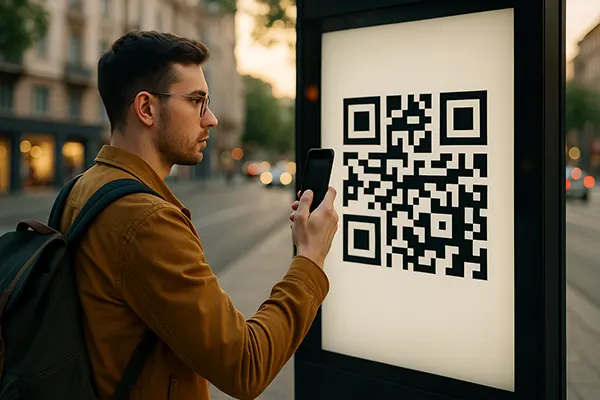
QR Codes in Outdoor Advertising: Bridging Digital and Physical Experiences
As marketing continues to evolve in the hybrid world of physical and digital touchpoints, the use of QR codes in outdoor advertising has become a practical method for creating seamless interaction with audiences. No longer a novelty, QR technology offers a direct channel to engage people instantly, track user behaviour, and provide contextual content. As of June 2025, its integration into outdoor campaigns is not just innovative — it’s essential.
The Practical Role of QR Codes in Modern Advertising
Outdoor advertising, traditionally static, now meets digital interactivity through QR codes. These small square patterns act as gateways to immersive experiences, turning posters, billboards, and transit ads into dynamic engagement tools. With smartphones universally equipped to scan QR codes, no app download is required, eliminating barriers to access.
Advertisers are now able to enrich their messaging beyond visuals and slogans. By linking to product videos, surveys, maps, discount offers or app downloads, QR codes offer multiple layers of interaction. For instance, a campaign for a new product launch can instantly direct passersby to a pre-order page, facilitating instant conversions.
Moreover, QR codes support personalisation. Campaigns can be segmented by location, time of day, or even audience demographic — delivering tailored content based on the data collected through scans. This bridges the gap between traditional branding and data-driven digital marketing.
Technological Advancements and User Behaviour
As of 2025, the adoption of 5G and increased mobile connectivity has made scanning QR codes faster and more reliable. Advances in image recognition ensure better scanning even in low light or from challenging angles, making them viable in various urban environments.
User comfort with QR codes has also increased. From restaurant menus to health passes, users have grown accustomed to their presence and function. This comfort translates into higher interaction rates with QR-enhanced out-of-home (OOH) campaigns, especially when the call-to-action is clear and compelling.
Data from recent surveys indicates that QR-integrated OOH ads achieve up to 40% more user interaction compared to non-interactive formats. This quantifiable benefit has reinforced confidence in allocating more budget to campaigns leveraging QR codes.
Best Practices for Implementing QR Codes in OOH Campaigns
Integrating QR codes into an advertising strategy involves more than placing a black-and-white square on a poster. To ensure efficiency, codes should be placed at eye level and within reach of the viewer, especially in pedestrian-heavy zones. Placement matters — what works for a bus stop may not suit a highway billboard.
Design also plays a crucial role. Codes should be large enough to scan from a reasonable distance and must contrast sharply with the background. A clear call-to-action such as “Scan to get 10% off” encourages engagement and informs the viewer about what they will gain.
Short, dynamic URLs improve scan speed and allow for easier data tracking. It’s also recommended to test QR codes under real-world conditions, including sun glare, rain, and crowd density. A/B testing different creatives and tracking interaction metrics can help refine campaign elements for optimal results.
Case Studies and Real-World Applications
Leading global brands have embraced QR-enhanced outdoor advertising. For instance, a major sportswear company used QR codes on city wall murals to drive traffic to an exclusive sneaker drop, achieving over 50,000 scans in three days. This initiative generated a viral buzz on social media, amplifying its reach.
In another example, a healthcare provider deployed QR-enabled posters in public transport stations offering free mental health resources. The approach not only increased awareness but also resulted in a 20% uplift in clinic appointments within the first month.
Small businesses are also leveraging the format. Local cafés and event organisers often use QR codes on sidewalk signs to distribute loyalty rewards, gather feedback or offer digital menus. The flexibility of the technology allows for high-impact interaction at a relatively low cost.

Measuring Effectiveness and Optimising Future Campaigns
The greatest strength of using QR codes in outdoor advertising lies in their measurability. Each scan delivers real-time data on user location, engagement time, and conversion behaviour. These insights help marketers fine-tune campaigns and justify return on investment (ROI) more accurately than traditional methods.
Analytics platforms now offer detailed dashboards tailored to QR performance. Data can be segmented by geography, device type, or even weather conditions during scan time. This level of granularity supports more strategic planning and helps identify underperforming assets in real time.
Marketers can also integrate QR engagement data into customer relationship management (CRM) tools, feeding targeted email or SMS follow-ups. In doing so, outdoor campaigns cease to be standalone efforts and become an integral part of cross-channel marketing strategies.
Forecast: The Future of QR-Driven Outdoor Advertising
Looking ahead, QR code use in OOH is expected to evolve through AI integration, where scanning a code may launch a personalised chatbot or augmented reality (AR) experience. These advancements will further blur the line between the physical and digital worlds.
Brands will increasingly incorporate QR codes into sustainable, interactive installations. For example, eco-friendly billboards that not only deliver digital experiences but also function as air purifiers or solar generators are gaining popularity in Europe and Asia.
Ultimately, as consumer expectations shift toward instant access and meaningful engagement, QR codes will remain an indispensable tool in modern outdoor advertising. The challenge lies not in the technology itself, but in how creatively and strategically it is applied.
